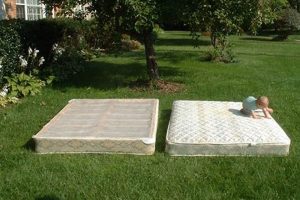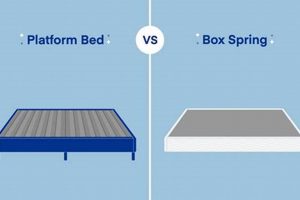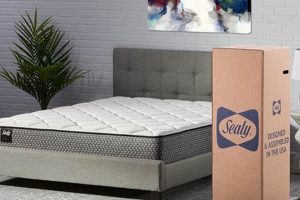The configuration involves utilizing a sleep surface absent of a traditional foundation. This support system is traditionally a framed structure containing springs or wooden slats, designed to elevate and provide support to the overlying sleep surface. A common illustration would be a foam or hybrid construction placed directly on a platform bed frame.
This approach to sleep system construction presents several advantages. It often reduces overall height, creating a lower profile aesthetic. It can also improve airflow and breathability, depending on the chosen frame and the support characteristics of the chosen sleep surface. Historically, the necessity of additional support was driven by the construction of innerspring units; however, advancements in materials science and design now allow for adequate support without it.
The subsequent discussion will examine suitable support structures, the implications for warranty and lifespan, and the types of sleep surfaces best suited for use without a conventional foundation, providing guidance for optimal comfort and longevity.
Guidance for Foundation-Free Sleep Surface Configurations
Optimizing the lifespan and performance of a sleep surface designed for use without a traditional foundation necessitates careful consideration of several factors. The following guidance provides insights to ensure proper support and maintain warranty compliance.
Tip 1: Platform Bed Selection: Ensure the platform bed frame features adequate slat spacing. Gaps exceeding 2-3 inches may compromise support and accelerate wear.
Tip 2: Solid Foundation Alternatives: Consider utilizing a solid platform or closely spaced slats for all-foam or heavier hybrid designs to prevent sagging and ensure even weight distribution.
Tip 3: Verify Warranty Requirements: Thoroughly review the manufacturer’s warranty documentation. Most warranties stipulate specific support requirements for validity, including acceptable frame types and slat spacing.
Tip 4: Weight Considerations: Account for the combined weight of the sleep surface and users. Exceeding the frame’s weight capacity can lead to structural failure and void warranties.
Tip 5: Monitor for Sagging: Regularly inspect the sleep surface for signs of sagging or unevenness. Early detection allows for prompt corrective action, potentially extending its lifespan.
Tip 6: Rotating the Sleep Surface: Rotate the sleep surface regularly, as recommended by the manufacturer, to promote even wear and prevent localized compression.
Tip 7: Appropriate Sleep Surface Type: Innerspring designs are generally less suitable for foundation-free use due to concentrated pressure points. Foam, latex, or hybrid designs with robust edge support are preferable.
Adhering to these guidelines will contribute to the longevity and comfort of the chosen sleep system. Proper support is crucial for both maintaining structural integrity and realizing the intended benefits of the design.
The next section will delve into specific material considerations and design features that further optimize the performance of sleep surfaces intended for use without conventional foundations.
1. Platform bed compatibility
The suitability of a platform bed frame for a sleep surface designed without a traditional foundation is paramount to ensuring proper support, comfort, and adherence to manufacturer warranty stipulations. The interaction between the platform bed and the sleep surface directly impacts its lifespan and performance.
- Slat Spacing and Support
Slat spacing dictates the level of support provided. Excessive gaps, typically exceeding 2-3 inches, can cause uneven weight distribution, leading to sagging and premature wear, especially in all-foam or hybrid constructions. Closely spaced slats, or a solid platform, offer superior support and prevent deformation. As an example, a memory foam unit placed on a frame with wide slat spacing may develop impressions more rapidly than one on a solid surface.
- Frame Material and Construction
The material and construction quality of the platform bed frame influence its load-bearing capacity and stability. Frames constructed from solid wood or reinforced metal offer greater support compared to those made from lower-quality materials. Insufficient structural integrity can lead to frame failure, potentially damaging the sleep surface and voiding warranties. For instance, a lightweight metal frame may buckle under the combined weight of a heavy hybrid unit and its occupants.
- Headboard and Footboard Attachment
The method of attachment of the headboard and footboard contributes to the overall stability and rigidity of the frame. Secure and robust connections prevent wobbling and ensure even weight distribution across the entire support structure. Loose or poorly attached headboards and footboards can compromise the frame’s integrity and increase the risk of sagging or damage. Imagine a scenario where a loosely attached headboard creates stress points, leading to frame warping over time.
- Weight Capacity Compliance
Adhering to the manufacturer’s specified weight capacity is crucial for preventing structural damage and maintaining warranty validity. Overloading the frame can result in bending, cracking, or complete collapse, rendering the sleep surface unusable and potentially causing injury. A common oversight is neglecting to consider the combined weight of the sleep surface and its occupants when selecting a platform bed frame. Exceeding the stated weight limit can lead to immediate or gradual frame failure.
These elements are intrinsically linked to the performance of a sleep surface intended for use without a traditional foundation. Choosing a platform bed frame that meets or exceeds the manufacturer’s requirements and addresses these considerations is vital for maximizing the longevity and comfort of the complete sleep system. Neglecting these compatibility factors can result in reduced lifespan, compromised support, and potential warranty issues.
2. Support Slat Spacing
Support slat spacing is a critical factor when employing a sleep surface without a traditional foundation. The distance between individual support slats directly influences the degree of support and the overall lifespan of the sleep surface. Insufficient support, stemming from excessive spacing, can lead to premature sagging and compromised structural integrity. This is particularly relevant for all-foam or hybrid sleep surfaces, where weight distribution relies entirely on the underlying framework. As an example, a memory foam unit placed upon slats spaced greater than three inches apart will exhibit accelerated compression and reduced resilience compared to the same unit supported by closely spaced slats or a solid platform.
Furthermore, manufacturer warranties often specify maximum acceptable slat spacing. Failure to adhere to these guidelines can invalidate the warranty, leaving the consumer responsible for repair or replacement costs. Consider a scenario where an individual experiences sagging within the warranty period, only to discover their claim is denied due to non-compliance with the slat spacing requirements outlined in the warranty documentation. Proper slat spacing is, therefore, not merely a matter of comfort, but also a financial consideration.
In summary, appropriate support slat spacing is essential for preserving the structural integrity and extending the lifespan of sleep surfaces utilized without traditional foundations. Non-compliance with manufacturer guidelines and inadequate support can lead to premature wear, compromised comfort, and potential warranty invalidation. Addressing this aspect is paramount when selecting or configuring a sleep system.
3. Warranty Implications
Utilizing a sleep surface without a traditional foundation introduces specific warranty considerations that consumers must understand to ensure coverage remains valid. Manufacturers often stipulate precise support requirements within warranty documents, outlining acceptable frame types, slat spacing, and weight distribution parameters. Deviating from these specifications can void the warranty, leaving the consumer responsible for repair or replacement costs associated with structural defects or premature wear.
For example, a common warranty clause may require the use of a platform bed with slats spaced no more than two inches apart. If a consumer uses a frame with wider spacing, the sleep surface may sag prematurely due to inadequate support. In such a case, the manufacturer may deny a warranty claim, arguing that the damage resulted from improper usage rather than a manufacturing defect. This highlights the critical importance of thoroughly reviewing warranty documentation and ensuring compliance with all specified support requirements.
In conclusion, understanding the warranty implications associated with using a sleep surface sans foundation is crucial for safeguarding the consumer’s investment. Adherence to the manufacturer’s support stipulations is paramount for maintaining warranty validity and preventing potential financial burdens resulting from premature wear or structural failure. Consumers are advised to prioritize research and ensure compliance with all warranty requirements before finalizing their sleep system configuration.
4. Weight distribution
When a sleep surface is employed without a traditional foundation, weight distribution becomes a paramount concern impacting both comfort and longevity. The absence of a spring-supported base necessitates careful consideration of how the sleep surface disperses the load it bears. Uneven weight distribution creates localized stress points, accelerating wear and potentially compromising the structural integrity of the unit. For instance, an all-foam unit placed directly on a platform bed with widely spaced slats will exhibit concentrated pressure in the areas between the slats, leading to premature sagging and diminished support in those specific regions.
Proper weight distribution, conversely, promotes uniform wear and extends the lifespan of the sleep surface. Support structures, such as closely spaced slats or solid platforms, facilitate this even distribution. A solid platform, for example, provides consistent support across the entire surface, minimizing localized pressure points. Consider the difference between a hybrid unit resting on a solid base versus one on a frame with significant gaps: the former is likely to maintain its shape and support characteristics for a longer duration due to the balanced dispersal of weight. This evenness is crucial for maintaining proper spinal alignment and minimizing discomfort.
In summary, the correlation between weight distribution and the effectiveness of a sleep surface lacking a traditional foundation is undeniable. Uneven distribution leads to accelerated wear and compromised support, while even distribution prolongs lifespan and maintains optimal comfort. Understanding this relationship and selecting appropriate support structures are essential for maximizing the investment in a sleep system.
5. Material Suitability
The selection of appropriate materials is paramount when configuring a sleep surface without a traditional foundation. The absence of a sprung base necessitates that the unit itself provides both support and conformability. Therefore, the inherent properties of the constituent materials dictate the overall performance and longevity of the sleep system.
- Foam Density and Support
Foam density directly correlates with support and durability. Higher-density foams offer greater resistance to compression and provide enhanced support, particularly crucial in the absence of a foundation. Lower-density foams may exhibit premature sagging and reduced support, leading to discomfort and a shortened lifespan. For instance, a high-density memory foam core can provide adequate support for back and stomach sleepers, while a low-density foam may only be suitable for lighter individuals or side sleepers.
- Latex Resilience and Responsiveness
Latex, whether natural or synthetic, exhibits exceptional resilience and responsiveness, making it well-suited for foundation-free setups. Its inherent elasticity allows it to conform to the body’s contours while providing consistent support. The open-cell structure of latex promotes airflow, mitigating heat retention and enhancing breathability. As an example, a natural latex layer can provide a buoyant and supportive sleep experience, minimizing pressure points and promoting spinal alignment.
- Hybrid Construction and Zoned Support
Hybrid designs, combining foam or latex with encased coils, can offer a balanced approach to support and comfort. Zoned support systems, featuring varying coil gauges or foam densities in different areas, provide targeted support to specific regions of the body. This is particularly beneficial for individuals with back pain or those who require enhanced lumbar support. A hybrid construction with reinforced edge support is also desirable to prevent edge collapse and facilitate ease of entry and exit.
- Cover Fabric and Breathability
The cover fabric plays a critical role in regulating temperature and moisture. Breathable fabrics, such as organic cotton or bamboo, promote airflow and wick away moisture, preventing overheating and enhancing comfort. Non-breathable fabrics, such as vinyl or synthetic blends, can trap heat and moisture, leading to discomfort and potentially promoting the growth of mold and mildew. A breathable cover fabric is essential for maintaining a cool and hygienic sleep environment.
The interplay of these material properties dictates the success of a sleep surface designed for foundation-free use. Careful consideration of foam density, latex resilience, hybrid construction, and cover fabric breathability is essential for optimizing support, comfort, and longevity. Selecting appropriate materials ensures that the unit can effectively perform its intended function without the assistance of a traditional foundation, providing a comfortable and supportive sleep experience.
6. Sagging prevention
Sagging, the gradual deformation of a sleep surface, represents a significant concern when utilizing a sleep system without a traditional foundation. The absence of a box spring or similar support structure places greater emphasis on the unit itself to maintain its shape and provide consistent support. Proactive sagging prevention measures are, therefore, crucial for maximizing the lifespan and comfort of such configurations.
- Adequate Support Structure
The choice of support structure beneath the sleep surface directly impacts sagging prevention. Platform beds with closely spaced slats or solid platforms provide more uniform weight distribution than frames with widely spaced slats. Insufficient support leads to concentrated pressure points, accelerating compression and sagging in those areas. Solid platforms, while offering optimal support, may limit airflow compared to slatted designs. Therefore, selecting a support structure that balances support and ventilation is essential. For example, reinforced platform beds with slats spaced no more than two inches apart are commonly recommended for all-foam or hybrid units.
- Material Selection and Density
The density and composition of materials within the sleep surface contribute to its resistance to sagging. High-density foams, latex, or innerspring systems with robust edge support offer greater resistance to compression and deformation compared to lower-density alternatives. The layering and arrangement of materials also play a role. For instance, a sleep surface with a high-density foam core and a supportive transition layer can better resist sagging than one with a uniform layer of low-density foam. Hybrid constructions that combine supportive coils with pressure-relieving foam layers can also provide enhanced sagging prevention.
- Proper Rotation and Maintenance
Regular rotation of the sleep surface helps to distribute wear and prevent localized compression, mitigating the risk of sagging. Rotating the unit 180 degrees every few months ensures that different areas bear the brunt of weight, promoting more even wear. Additionally, avoiding prolonged sitting or concentrated pressure in specific areas can help to prevent localized sagging. Following the manufacturer’s recommendations for maintenance and care is crucial for preserving the structural integrity of the sleep surface. For example, regularly vacuuming the surface can remove dust mites and allergens, while using a waterproof cover can protect against spills and stains, both of which can contribute to material degradation and sagging.
- Weight Capacity Compliance
Exceeding the weight capacity of the sleep surface or its support structure can significantly accelerate sagging. Overloading the unit creates excessive stress on the materials, leading to premature compression and deformation. Weight capacity limitations should be carefully considered when selecting a sleep surface, particularly for individuals with higher body weights or couples sharing the unit. Exceeding the recommended weight limit can not only compromise support and comfort but also void the manufacturer’s warranty. Ensuring that both the sleep surface and its support structure are rated to accommodate the combined weight of all users is a critical step in sagging prevention.
These facets underscore the importance of proactive sagging prevention when foregoing a traditional foundation. The selection of an appropriate support structure, the use of durable materials, adherence to proper maintenance practices, and compliance with weight capacity limitations are all essential for maximizing the lifespan and maintaining the comfort of a sleep system.
7. Frame Structural Integrity
The structural integrity of a bed frame assumes heightened importance when a sleep surface is utilized without a traditional box spring. In such configurations, the frame bears the entirety of the load, and its stability directly impacts the support, comfort, and longevity of the unit. Compromised frame integrity can lead to uneven weight distribution, accelerated wear, and potential structural failure.
- Material Composition and Joint Strength
The materials used in frame construction and the strength of their connections directly influence the frame’s ability to withstand weight and resist deformation. Solid hardwood or reinforced metal frames offer greater stability compared to frames constructed from particleboard or lightweight alloys. Securely fastened joints, employing bolts and screws rather than staples or glue, are essential for maintaining structural integrity over time. An example includes a solid oak frame with bolted joints, which is significantly more resistant to warping and breakage than a frame made from composite wood with glued connections.
- Slat Configuration and Support Span
The configuration of support slats and the distance they span between supporting members determine the level of support provided to the sleep surface. Closely spaced slats, typically no more than two to three inches apart, offer superior support and prevent sagging, particularly for all-foam or hybrid units. Wider slat spacing can create pressure points and lead to premature wear. Consider the difference between a sleep surface placed on a frame with five-inch slat spacing versus one with two-inch spacing; the former is more likely to develop indentations and exhibit reduced support.
- Load-Bearing Capacity and Weight Distribution
Adhering to the manufacturer’s specified load-bearing capacity is crucial for preventing frame failure and maintaining warranty validity. Overloading the frame can result in bending, cracking, or complete collapse, rendering the sleep surface unusable. Furthermore, proper weight distribution is essential for preventing localized stress points. Regularly rotating the sleep surface and avoiding concentrated pressure in specific areas can help to distribute wear and extend the frame’s lifespan. For instance, consistently sitting on the edge of the unit can weaken the frame’s edge supports over time, leading to eventual failure.
- Center Support and Reinforcement
Center support, particularly in larger frames, is critical for preventing sagging and maintaining even weight distribution. A center support beam, running lengthwise along the frame, provides additional reinforcement and prevents the frame from bowing under the weight of the sleep surface and occupants. Frames lacking adequate center support are more prone to sagging and structural failure. Envision a queen-sized frame without center support, which is likely to exhibit significant bowing and reduced support compared to a similar frame with a robust center beam.
In conclusion, the structural integrity of the bed frame is a non-negotiable factor when opting for a sleep surface without a box spring. Selecting a frame constructed from durable materials, featuring a supportive slat configuration, adhering to weight capacity limitations, and ensuring adequate center support are all essential for maximizing the lifespan and performance of the sleep system. Neglecting these considerations can lead to premature wear, compromised comfort, and potential safety hazards.
Frequently Asked Questions
The following addresses common inquiries regarding the implementation of sleep systems designed for use without a box spring or similar support structure. Clarity on these points promotes informed decision-making and optimized sleep system performance.
Question 1: What frame types are compatible with a sleep surface designed without a box spring?
Compatible frame types include platform beds with closely spaced slats (typically no more than 2-3 inches apart), solid platforms, and adjustable bed bases. It is essential to verify the manufacturer’s recommendations to ensure compatibility and maintain warranty validity.
Question 2: How does using a sleep surface without a box spring affect its lifespan?
Lifespan can be either positively or negatively affected, depending on several factors. Appropriate support from the chosen frame, proper weight distribution, and adherence to the manufacturer’s care instructions are crucial. Inadequate support can lead to premature sagging and reduced lifespan.
Question 3: Are all sleep surface types suitable for use without a box spring?
No, not all designs are equally suitable. All-foam, latex, and hybrid designs with robust edge support are generally preferable. Innerspring designs may require additional support to prevent sagging and maintain proper spinal alignment.
Question 4: Does foregoing a box spring void the manufacturer’s warranty?
It may, depending on the specific terms of the warranty. Manufacturers often stipulate minimum support requirements, including acceptable frame types and slat spacing. Failure to comply with these requirements can invalidate the warranty.
Question 5: How does weight distribution affect a sleep surface used without a box spring?
Uneven weight distribution creates localized stress points, accelerating wear and potentially compromising the structural integrity of the unit. Proper support, such as closely spaced slats or a solid platform, facilitates even distribution and prolongs lifespan.
Question 6: What are the benefits of using a sleep surface without a box spring?
Potential benefits include a lower profile aesthetic, improved airflow (depending on the frame), and cost savings associated with eliminating the need for an additional support structure. The absence of springs in the foundation can also reduce noise.
In summary, careful consideration of frame compatibility, support, warranty requirements, and weight distribution is essential for optimizing the performance and lifespan of a sleep surface used without a traditional foundation. Informed decision-making promotes a comfortable and supportive sleep environment.
The next section will explore specific case studies and real-world examples to further illustrate the principles discussed.
Conclusion
This exploration has delineated the critical factors influencing the performance and longevity of sleep surfaces used without traditional foundations. Key considerations include frame compatibility, support slat spacing, warranty implications, weight distribution, material suitability, sagging prevention, and frame structural integrity. These elements collectively determine the efficacy of such configurations, highlighting the need for informed decision-making.
Understanding these principles is paramount for optimizing sleep system performance and realizing the intended benefits. Prioritizing appropriate support structures and adhering to manufacturer guidelines ensures sustained comfort and maximizes the lifespan of the chosen sleep surface. Continued vigilance and proactive maintenance are essential for preserving the integrity of these foundation-free systems in the long term.




![Best Queen Bed Mattress with Box Spring Set [Deals] Organic & Natural Mattress Buyer’s Guide: Non-Toxic Sleep Solutions Best Queen Bed Mattress with Box Spring Set [Deals] | Organic & Natural Mattress Buyer’s Guide: Non-Toxic Sleep Solutions](https://mattressworldpa.com/wp-content/uploads/2025/07/th-3379-300x200.jpg)


